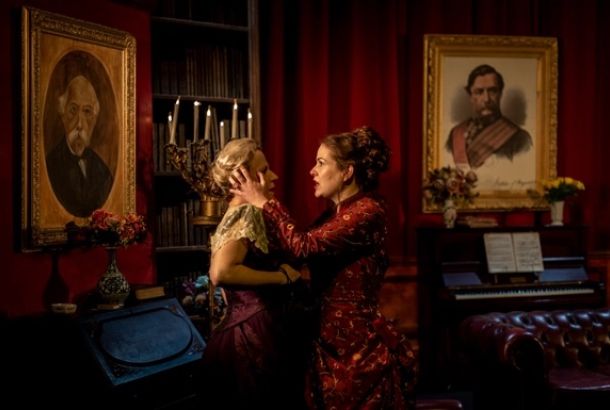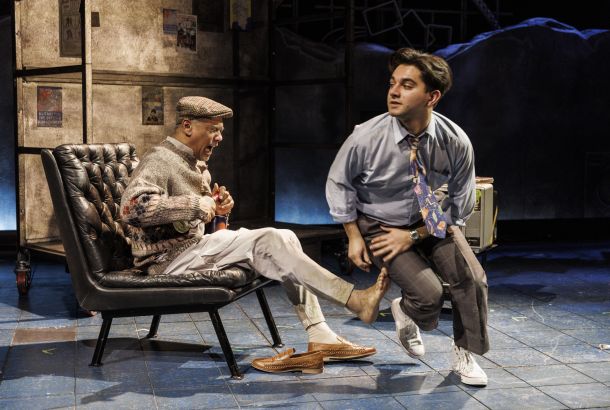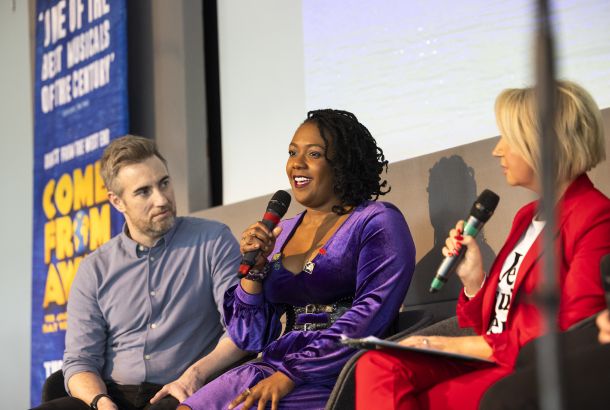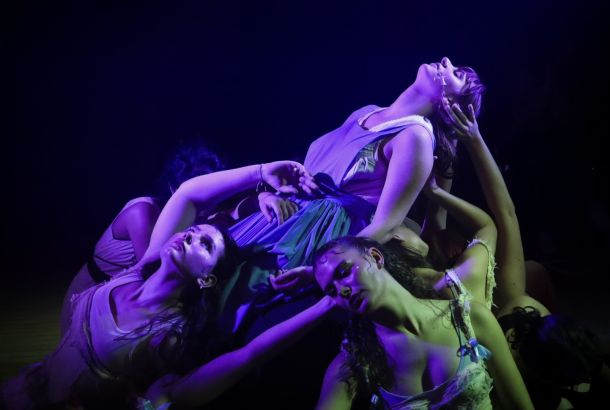
I’m not a huge fan of opera. I have seen almost every opera I have ever wanted to see (The Merry Widow, The Magic Flute and Carmen; I’m just yet to see Madama Butterfly and Aida). All three of those operas were by Opera North, who make operas for modern audiences; I’m not sure I’d enjoy them if they were not modernised.
As much as I love Greek mythology, I had never fancied an opera based on the Greek myth of Orpheus. Indeed, when I first saw Opera North’s latest season, I had not planned on seeing anything. But then I discovered that Orpheus was, in fact, a modern, Indian reimagining of Monteverdi’s L’Orfeo – and I knew I had to see it! Its arrival in Manchester was poignant, given all of the South Asian theatre in the city this month.
Now, no story is as important to opera as the Greek myth of Orpheus and Eurydice. It is the most common story in operas from the 16th to the 20th centuries, and it is one of the first stories ever to be turned into an opera.
Indeed, whilst the first work in the opera genre is Jacopo Peri’s Dafne, the earliest surviving opera is Peri’s Euridice, and the earliest opera that is still regularly performed is Monteverdi’s L’Orfeo, also known as La favola d’Orfeo, or just Orfeo.
Another well-known operatic retelling of the myth is Gluck’s Orfeo ed Euridice, which was featured in Opera North’s latest season, as a stripped-back concert.
I often say that Opera North do to opera what the Royal Shakespeare Company (RSC) do to Shakespeare: they contemporise classic works by changing the setting. Orpheus, however, is much more radical: it is not merely L’Orfeo with a new facade but, rather, a complete reimagining, with brand-new (classical Indian) music by Jasdeep Degun (thus, it can be compared to Matthew Bourne‘s interpretations of classic ballets).
Reimagining operas – and doing the unthinkable by changing the music – is controversial. Indeed, Degun’s reinvention of one of the most popular operas of all time is ambitious – and, ultimately, triumphant.
The Design
We walked into the auditorium to a raised curtain and a finely decorated stage. At the back of the stage were two models of terraced houses, each intricately designed, complete with drain pipes and LED lights over the main house. The windows all offered a little insight into the going-ons of each room, and throughout the course of the opera, lights switched on and off, creating a real sense of life. Behind the houses was a blue sky, which, too, changed colour depending on the time of day.
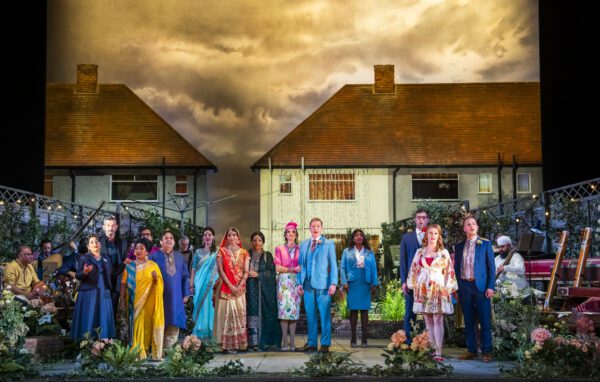
The main action, meanwhile, took place in the garden belonging to the main house. There were fences at either side, each covered in plants and lights. The orchestra sat at either side of the garden, allowing the cast to perform in the middle. The orchestra was a part of the action; when guests arrived, they greeted the orchestra, who responded accordingly. The orchestra were, themselves, playing a band, performing at the wedding of Orpheus and Eurydice.

The set stayed mostly the same for the entirety of the piece. In the second act, when Orpheus travels to the Underworld – on the hunt for his deceased wife, Eurydice – the garden remains in place, but the house is nowhere to be seen, and instead of a rich, blue sky, there is just black. Balloons dangled from the ceiling, including a large heart-shaped one – and they occasionally lit up.
Keeping the set mostly the same, even whilst Orpheus is in the underworld, created a dream-like feeling of entrapment and futility – as if Orpheus is destined to return to the garden alone, and his visit to the Underworld is merely a fantasy. Towards the end of the final act, a black curtain covered the back of the stage, and thus Eurydice, before moving away to reveal the terraced houses; we were back where we started. It was a dramatic but seamless transition.
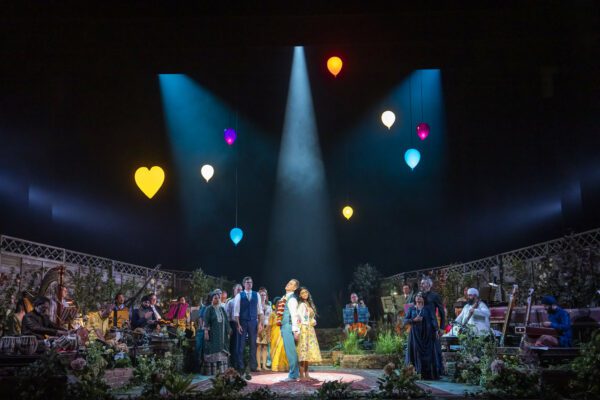
That said, there was a missed opportunity in creating a dramatic landscape for the Underworld. At times, the second act felt more like a concert performance; actors/singers, the orchestra, and black. But the creatives clearly wanted the Underworld to feel more like the abyss (as Pluto calls it, himself).
The stripped-back nature of the Underworld elevated the emotional power of the music and the story. Yes, Orpheus was in the Underworld, but the creatives did not want us to get lost in that; at its core, this is a story about love and longing. After all, the opera uses the more positive Pluto, rather than the hellish Hades.
The costumes were as beautiful as the set design, especially the traditional Indian garments, such as saris. The way they twinkled and sparkled in the stage light was captivating, and they added a sense of drama whenever any dancing took place.

The Music
Degun masterfully fused together the original Italian score with brand-new (but classical) Indian music. On paper, it should not work, but in action, it is divine.
The opera opened as the original does, with La musica, representing the “spirit of music”, telling the tale of star-crossed lovers. In this version, La musica is split in two: a European woman, La musica (Amy Freston), who sings in Italian, and a South Asian woman, Sangeet (Deep Nair Rasiya), who sings in a South Asian language. “Sangeet” means a Northern Indian wedding music ceremony.
In the scene that follows, the women seem to portray maternal figures of Orpheus (Nicholas Watts) and Eurydice (Ashnaa Sasikaran).
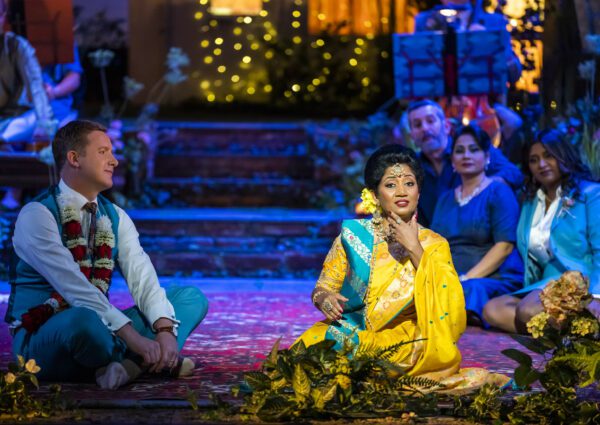
The angel-voiced Sanchita Pal – who played Asparā (Nymph) – won the hearts of the audience. Her movements were similar to Kathak, and her fellow South Asian co-stars similarly embodied other South Asian cultures and dance forms.
Other standout performances came from Kezia Bienek as Silvia (The Messenger), the ethereal Yarlinie Thanabalasingam as Nambikkai (Hope), the captivating Chandra Chakraborty as Prosperina, the striking Dean Robinson as Pluto, and the regal Kirpal Singh Panesar as Apollo.

Degun chooses not to use only one South Asian language. Instead, he pays tribute to ethnicities and cultures all over the Indian subcontinent, with an ethnically diverse cast who sing in different languages. There is also a variety of South Asian dance and movement in the piece, as well as instruments from all over the subcontinent. It really is a love-letter to South Asian culture and identity.
A highlight of the East-West fusion comes during the wedding, when the family take part in a celebratory dance. The number flips between Italian and an Indian language, with the cast repeating the same words in both languages. During the Italian parts, the dancing is more Western; doing the Indian part, they do traditional Indian dancing (it looks a little like Garba). The White actors appeared comfortable doing the Indian dance, and they made it seem as if they were copying the movements of their Indian friends. It felt very real, like you would imagine a mixed-White/Indian wedding.
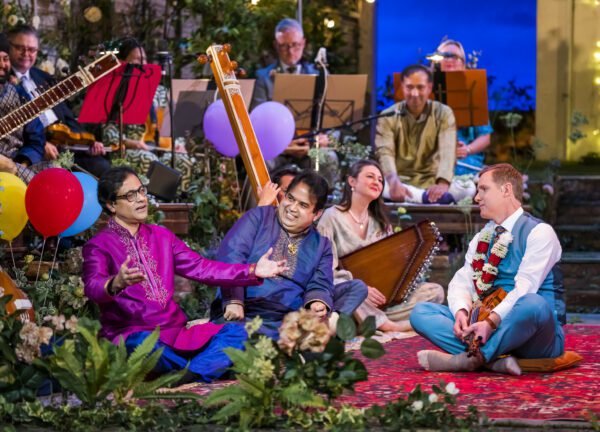
Later, two Shephards (or Chavaraaho), played by Chiranjeeb Chakraborty and Vijay Rajput, sat with Orpheus. They taught him how to sing like them (Indian singing often involves lots of noise, devoid of any actual words, such as “oohs” and “ahhs”). Watt’s attempt to sing in that style deserves great praise. One of the Indian men produced a noise that was simply not replicable, much to the humour of the audience.
In the second act, there is a divine drumming sequence, in which two Indian members of the orchestra showed off their tabla skills, producing the biggest applause in the entire piece, until the curtain call.

Orpheus is a masterclass on how you reinvent a classic for modern audiences, to tell the same story in a new way, to breathe life into what some consider a dying art form. The Indian-Italian fusion produces an experience for the senses: it is visually stunning and aurally satisfying. I have seen and reviewed several operas, all by Opera North, and this was the best, by far. I’m not sure how they – or anyone, for that matter – can top it.
For more Opera North content, check out our review of the company’s stripped-back, concert version of Gluck’s Orfeo ed Euridice. Both L’Orfeo and Orfeo ed Euridice are based on the Greek myth of Orpheus and Eurydice; the most common story in operas from the 16th to the 20th century.
